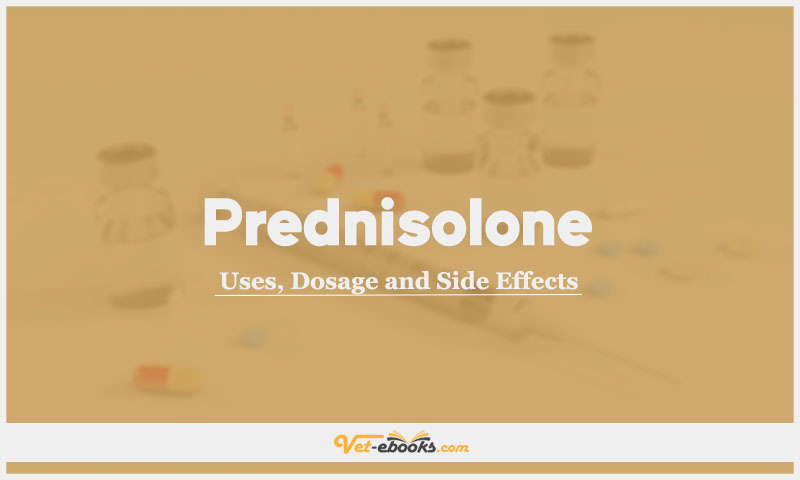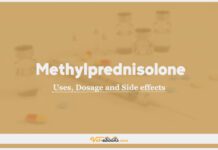Prednisolone In Dogs & Cats: Uses, Dosage and Side Effects

Overview
- This substance binds to specific cytoplasmic receptors.
- Once bound, these receptors enter the nucleus and modify DNA transcription.
- These alterations in DNA transcription lead to changes in cellular metabolism.
- The result is a range of effects, including anti-inflammatory, immunosuppressive, and anti-fibrotic effects.
- Additionally, it exhibits glucocorticoid activity.
- In dogs, it functions as an antagonist of ADH (antidiuretic hormone).
Uses of Prednisolone
Management of:
- Chronic allergic/inflammatory conditions (e.g. atopy, inflammatory bowel disease).
- Immune-mediated conditions.
- Hypoadrenocorticism.
- Lymphoproliferative and other neoplasms.
- In combination with cinchophen (PLT), it is used in the management of osteoarthritis.
Dose of Prednisolone in Dogs and Cats
Dogs:
- Ophthalmic: dosage frequency and duration of therapy is dependent upon the type of lesion and response to therapy. Usually, 1 drop in affected eye(s) q4–24h tapering in response to therapy.
- Hypoadrenocorticism: starting dose 0.2 mg/kg with desoxycortone pivalate (DOCP), 0.1 mg/kg with fludrocortisone. The dose of prednisolone may be reduced considerably in most cases once the animal is stable. In cases on fludrocortisone, it may be discontinued but in cases on DOCP, it should be continued albeit at a low dose.
- Allergy: 0.5–1 mg/kg p.o. q12h initially, tapering to the lowest q48h dose.
- Anti-inflammatory: 0.5 mg/kg p.o. q12–24h; taper to 0.25–0.5 mg/kg q48h.
- Immunosuppression: 1–2 mg/kg p.o. q24h, tapering slowly to 0.5 mg/kg q48h (for many conditions this will take 6 months).
Cats:
- Ophthalmic, hypoadrenocorticism, allergy: doses as for dogs.
- Anti-inflammatory: 0.5–1 mg/kg p.o. q12–24h; taper to 0.5 mg/ kg q48h.
- Immunosuppression: 1–2 mg/kg p.o. q12–24h, tapering slowly to 0.5–1 mg/kg q48h (for many conditions this will take 6 months)
Drug Dosage Calculator
You Should Give:
Side Effects of Prednisolone in Dogs and Cats
- Prolonged use of glucocorticoids can lead to suppression of the hypothalamic–pituitary axis (HPA).
- This suppression can cause adrenal atrophy.
- In dogs, prolonged use of glucocorticoids may result in significant proteinuria and glomerular changes.
- The catabolic effects of glucocorticoids can lead to weight loss and muscle atrophy.
- Chronic use of glucocorticoids can lead to the development of iatrogenic hyperadrenocorticism.
- Adverse gastrointestinal effects may include vomiting, diarrhea, and GI ulceration, which may be more severe when corticosteroids are used in animals with neurological injury.
- Other potential side effects include hyperglycemia and decreased serum T4 values in patients receiving prednisolone.
Contraindications of Prednisolone in Dogs and Cats
- Do not use in pregnant animals.
- Systemic corticosteroids are generally contraindicated in patients with renal
disease and diabetes mellitus. - Topical corticosteroids are contraindicated in ulcerative keratitis.
Some Notes:
- There is an elevated risk of gastrointestinal ulceration when corticosteroids are used concurrently with NSAIDs.
- Hypokalemia, or low potassium levels, may develop if corticosteroids are administered alongside medications like acetazolamide, amphotericin B, or potassium-depleting diuretics such as furosemide and thiazides.
- Glucocorticoids can potentially counteract the effects of insulin.
- The metabolism of corticosteroids may be accelerated when used with phenytoin or phenobarbital, but it may be reduced when combined with antifungal medications like itraconazole.
Tip
Do You Want To Increase Your Veterinary Knowledge and Practical Skills?
You Can Now Browse and Download +3000 Books For Veterinary Professionals & Students Online.
Download Veterinary Books




















